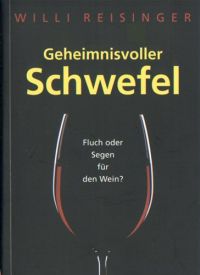This book is not new in the sense of being hot off the press. It was published in 2009, but it is dedicated to a virtually timeless topic and is therefore still topical. The compact work is called "Mysterious Sulphur", and in it author Willi (full name: Friedrich Wilhelm) Reisinger explores the question formulated in the subtitle, whether the chemical element in question is "a curse or a blessing for wine".
With "experience in three different professions, viticulture, apparatus engineering and the chemical industry" (as he writes on page 11), Reisinger has advanced to become an expert on must desulphurisation since the end of the 1970s, and the book is something like the documentation of his life's work, or at least "a long-cherished heart's desire" (page 92). For a book with just under 100 pages, three introductory words (from the district administrator of the Mainz-Bingen district, from the head of the viticulture & oenology department at the DLR Rheinpfalz and from the father of Reisinger's son-in-law) are quite a lot in addition to the author's foreword; in total, this four-part introduction alone fills eleven pages. The introductory words - in which the author is sometimes called "Mr Reisinger", sometimes "my friend Willi" - sometimes seem a bit sedate, but they illuminate the background of the book and the author in a meaningful way. Thus it becomes clear right at the beginning of the reading, which is also generally evident in the writing style: "Mysterious Sulphur", although non-fiction, is a very personal work, written with equal parts expertise and dedication.
 "This little booklet deals with the use of sulphur in the production and storage of wine," Reisinger sums up in his preface (page 10). And the book does full justice to this claim. In over 70 small chapters, Reisinger looks at the chemical properties of the element sulphur, the history of the use of sulphur in food production, the effect of sulphur on the organism of living beings and the use of sulphur in agriculture and industry. He goes into detail about winemaking (especially fermentation and fining) and explains the role played by the sugar content of wine and the limits for sulphurous acid in wine. He describes different types of sulphurisation and, with reference to biogenic amines in wine, dispels the prejudice that sulphur causes headaches after drinking wine. Wine labelling law, the sweet reserve and its preservation as well as climate change are also discussed.
"This little booklet deals with the use of sulphur in the production and storage of wine," Reisinger sums up in his preface (page 10). And the book does full justice to this claim. In over 70 small chapters, Reisinger looks at the chemical properties of the element sulphur, the history of the use of sulphur in food production, the effect of sulphur on the organism of living beings and the use of sulphur in agriculture and industry. He goes into detail about winemaking (especially fermentation and fining) and explains the role played by the sugar content of wine and the limits for sulphurous acid in wine. He describes different types of sulphurisation and, with reference to biogenic amines in wine, dispels the prejudice that sulphur causes headaches after drinking wine. Wine labelling law, the sweet reserve and its preservation as well as climate change are also discussed.
Reisinger explains clearly, practically and understandably, but a basic knowledge of chemistry is at least an advantage when reading the book. The reader is expected to know what higher-value alcohols are as well as what happens during esterification. Whether one speaks of "grape, fermentation and lager bouquet" (page 41) or prefers to speak of primary, secondary and tertiary aromas is a matter of opinion - however, it seems factually incorrect to state that the lager bouquet is "is also referred to as secondary grape bouquet" (page 41); the secondary grape bouquet comprises the aromatic substances that develop during the processing of the grapes but before fermentation. Reisinger's style is at times somewhat avuncular-narrative, he writes in the first person, often refers to his own experiences and enters into a fictional dialogue with the reader. He even closes the book with a greeting like a letter (page 88). For a non-fiction book, this may take some getting used to, but in this way, as a reader, you feel taken by the hand, as if you were sitting opposite the author and being introduced to the secrets of wine chemistry in a chatty tone.
"Mysterious Sulphur" is a useful compendium for anyone interested in the chemistry of wine and especially the role of sulphur. As said, some knowledge of chemistry helps in the immediate understanding of all the processes described, but overall Reisinger describes the scientific relationships in an appropriate level of detail. The quintessence, namely the four functions of sulphur in winemaking and storage, is summarised twice by Reisinger (on page 36 and page 90): sulphur dioxide (which, when dissolved in water, produces sulphurous acid, the salts of which are called sulphites) binds oxygen, inhibits enzymes, deprives microorganisms of their basis of life and influences the taste of the wine. In this respect, sulphur dioxide is a unique preservative to which there is no alternative because of its multifunctionality and effectiveness: "... the sulphur in wine is not an additive, but a necessary adjuvant!" (page 91)
Due to the fact that the book was published four years ago, two newer points of view are naturally missing: on the one hand, the EU Organic Wine Regulation (Cellar Directive) of 2012, which also contains its own sulphite limits for organic wines, and on the other hand, the increasingly observable trend towards unsulphurised wines (so-called natural or experimental wines). However, these points are not essential to the fundamental character of the book, and in any case Willi Reisinger has succeeded in providing a comprehensive, catchy and contemporary treatment of the subject of wine and sulphur.
Willi Reisinger
Geheimnisvoller Schwefel
Verlag Willi Reisinger
Druckerei Wolf, Ingelheim
June 2009
ISBN 978-3-00-026095-7
€ 9.95